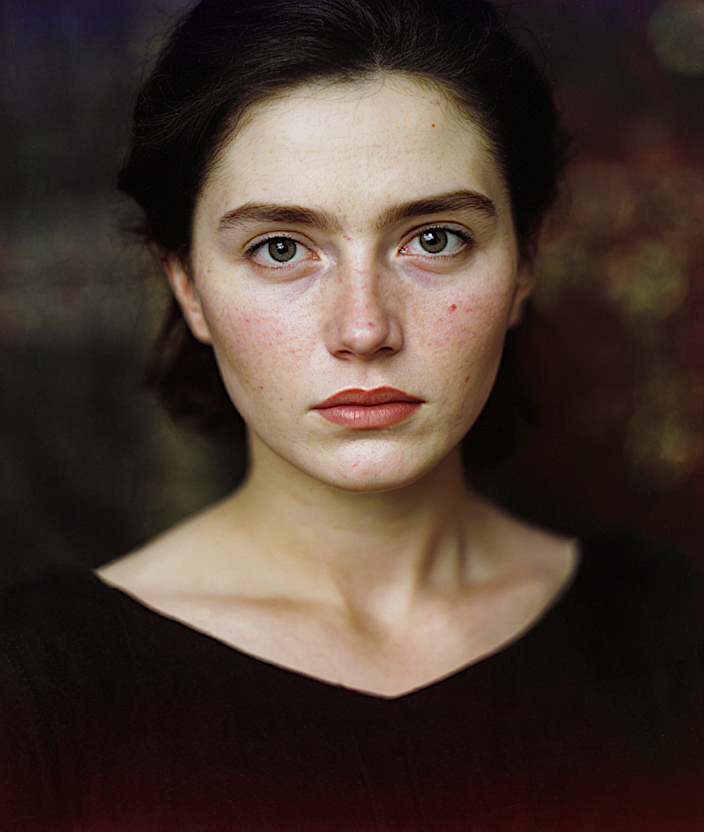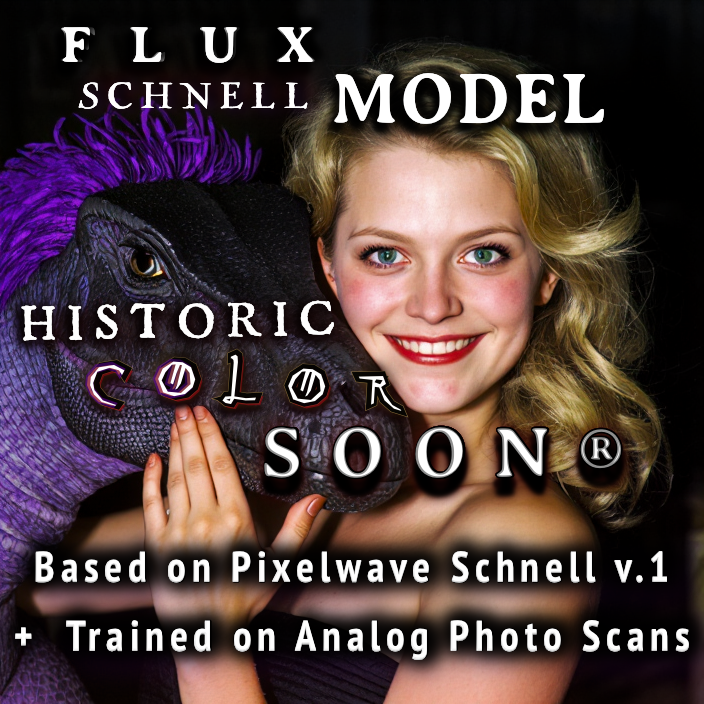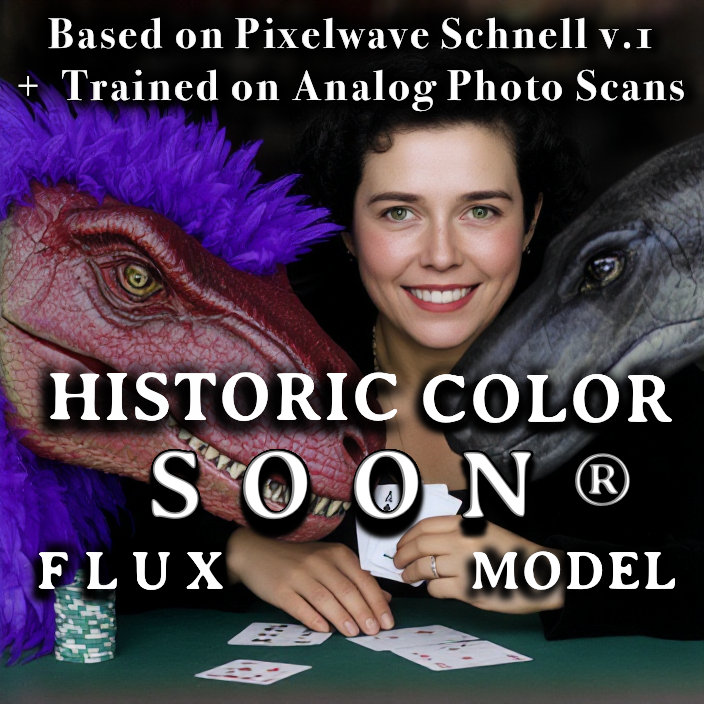
- Prompt
- HST style autochrome film photograph portrait of 1910 woman playing poker against a purple feathered dinosaur, the green-eyed woman has moderately blemished skin with visible lines and pores, she smiles, film grain, Kodachrome

- Prompt
- film photograph portrait of a woman

- Prompt
- film photograph portrait of blonde woman dancing with a purple feathered dinosaur, the green-eyed woman has moderately blemished skin with visible lines and pores, she smiles, film grain, Kodachrome
Historic Color Soon® (by A.C.T. Soon®)
Herein lives a versatile visual + textographic generative model especially catered to:
- Quality generation at a low step-count (2 to 8, for most scenarios), with 4-step inference at around 768x768 routinely producing photorealistic outputs at a quality comparable to or even surpassing that of Flux v.1 Dev.
- Producing realistic images reminiscent of color film analog photography, exhibiting parallels to a broad spectrum of iconic instrumentalities and visual paradigms, from Autochrome-to-Kodachrome-to-Fujifilm-and-beyond.
- Producing visuals with a vaguely "historical" or "lived-in" aesthetic character, striking chromaticity and luminosity dynamics, as well as textural/anatomical/skin details more reliably lifelike than other models at a comparable step-count/resource expenditure.
Foundations/Methods/Tools:
- Primary Base Model: FLUX.1-schnell by Black Forest Labs.
- Secondary Base Model: Pixelwave Schnell V.1 by HumbleMikey. The Safetensors & GGUF weights for it are found here at HF, and/or via the model's CivitAI page here).
- Finetuning (of Pixelwave Schnell V.1), mainly on around 500 color photographs taken during the 1900s and 1910s by Sergey Prokudin-Gorsky, who traveled and photographed widely in those years while pioneering and perfecting implementations of an early three-color-composite photography technique.
We urge you to explore the work of Prokudin-Gorsky for yourself, at the wonderfully organized online archive at this link, featuring many hundreds of high quality downloadable scans of composite color photo prints from the photographer's original glass plate negatives, available at this site alongside relatively recent restorations of a substantial portion of the images.
The original glass-plate negatives, alongside a large archive of prints (and other relevant artifacts, documents, and exhibits) are currently held at and administrated by the Library of Congress in Washington, DC, USA.
- Full-rank LoRA fine-tuning of FLUX.1-schnell on 130 photographs from the same dataset, to create the first LoRA prefiguration of this model: the Historic Color Schnell LoRA.
- Experiments with training five more LoRAs, using similar datasets, and targetting only select blocks in Schnell (and/or Dev).
- Merging the most successful among the latter results with Historic Color Schnell LoRA, using the 'flux_merge_lora.py' script from the sd3-branch /networks of Kohya-ss's sd-scripts git, whilst – wherever neccessary – converting the LoRAs (between ai-toolkit/Diffusers-adjacent and the Kohya/sd-scripts formats) using the 'convert_flux_lora.py' script at the same source.
- Merging the resulting LoRa into the checkpoint finetuned earlier from Pixelwave Schnell v.1.
- Ostris' training adapter for Schnell found here: ostris/FLUX.1-schnell-training-adapter.
Trigger Words:
You may use HST to bolster the vintage/autochrome effect. Though, in contrast with the Historic Color LoRA(s), the trigger does not appear to be quite as impactful towards the checkpoint.
Historical Note:
Prokudin-Gorsky's color photography technique would involve three photo-exposures, either simultaneous or sequential, using specialized color-spectrum filters (basically R.B.G.: red, blue, and green), rendering a subject/shot onto glass plates covered with light-emulsive mixture.
The photographer's focus on refining the developer and filter quality, in tandem with his incessant and wide-ranging experimentation, and his artful optimizations of glass plates (generally unwieldly, esp. for color, and by the 1910's already becoming outmoded for B&W on-location shoots, though elsewise extra reliable) ultimately led him to produce a color photography oeuvre of much greater fidelity and vividness than achieved by most of his contemporaries.
At the same time, the peculiarities of the photographer's method, coupled with his exceptionally hands-on execution thereof, would manifest in a range of idyosyncratic color, light, and motion artifacts common across the resulting prints.
Seldom marring the image as a whole, and less grave than the weaknesses of some contemporenously emerging autochrome techniques, the warm color hazes and flares framing many of Prokudin-Gorsky's prints may be seen as a kind of ephemeral signature.
Alongside some of the more subtle chromatic, textural, and (in some measure) figural characteristics of his work, these auras have reliably imprinted themselves into this Flux Schnell LoRA, the fourth in our series of historical adapters for Flux.
Download Model:
Weights for 'Historic Color SOON®' are available in Safetensors format in a separate repo.
Download them in the Files & versions tab.
The model is available in 🧨 Diffusers format within this repo.
Diffusers:
To use Historic Color SOON® with the 🧨 diffusers python library, first install or upgrade diffusers:
pip install -U diffusers
Then you can use FluxPipeline to run the model:
import torch
from diffusers import FluxPipeline
pipe = FluxPipeline.from_pretrained("Shakker-Labs/AWPortrait-FL", torch_dtype=torch.bfloat16)
pipe.to("cuda")
pipe.enable_model_cpu_offload() #save some VRAM by offloading the model to CPU. Remove this if you have enough GPU power
prompt = "HST style autochrome film photograph portrait of 1910 woman playing poker against a purple feathered dinosaur, the green-eyed woman has moderately blemished skin with visible lines and pores, she smiles, film grain, Kodachrome"
image = pipe(
prompt,
guidance_scale=1.2,
num_inference_steps=4,
max_sequence_length=256,
generator=torch.Generator("cpu").manual_seed(0)
).images[0]
image.save("hstcolor1.png")
To learn more check out the diffusers documentation.
Also, if you're into literature broadly and old modernist poetry specifically, check out my verse translations at SILVER AGE POETS!
- Downloads last month
- 36
Model tree for AlekseyCalvin/HistoricColorSoonr_Schnell
Base model
black-forest-labs/FLUX.1-schnell


